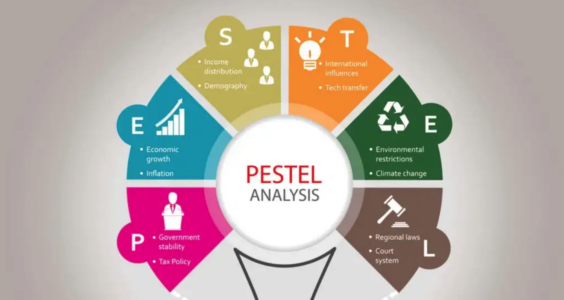PESTLE Analysis: A Strategic Tool for Understanding the External Environment

PESTLE Analysis is a strategic framework that helps organizations evaluate external factors influencing their operations and decisions. By examining Political, Economic, Social, Technological, Legal, and Environmental elements, businesses can anticipate challenges, identify opportunities, and align their strategies with the external environment.
In this article, we’ll dive into what PESTLE Analysis is, how to conduct one, and its applications in strategic planning.
What is PESTLE Analysis?
PESTLE is an acronym representing six external factors that impact businesses:
- Political: Government policies, trade regulations, and political stability.
- Economic: Economic conditions such as inflation, interest rates, and currency fluctuations.
- Social: Societal trends, cultural norms, and consumer behaviors.
- Technological: Innovations, digital transformation, and tech adoption.
- Legal: Regulatory compliance, labor laws, and intellectual property rights.
- Environmental: Sustainability issues, climate change, and resource availability.
PESTLE is particularly useful for strategic planning, market entry analysis, and risk management.
Benefits of PESTLE Analysis
- Holistic View: Offers a comprehensive understanding of external factors.
- Risk Mitigation: Identifies potential threats early, enabling proactive measures.
- Opportunity Identification: Highlights trends and external drivers for growth.
- Informed Decision-Making: Helps align strategies with macro-environmental realities.
How to Conduct a PESTLE Analysis
Step 1: Define Your Scope
Clarify the objective of the analysis. Are you analyzing the business environment for an entire company, a specific region, or a new product?
Example: Assess the external factors affecting market expansion in Asia.
Step 2: Gather Data for Each PESTLE Factor
Conduct thorough research using reliable sources like government reports, industry publications, and market research studies.
Political Factors
Evaluate how government policies and political stability affect your business.
- Tax policies
- Trade regulations
- Political stability
- International relations
Economic Factors
Understand the financial environment influencing your operations.
- Inflation rates
- Exchange rates
- Unemployment levels
- Consumer spending
Social Factors
Analyze societal trends and cultural norms impacting customer behavior.
- Demographics
- Lifestyle changes
- Education levels
- Social attitudes toward products/services
Technological Factors
Identify how technology trends can influence your industry.
- Emerging technologies
- R&D investments
- Automation
- Internet penetration
Legal Factors
Examine legal and regulatory frameworks relevant to your business.
- Employment laws
- Health and safety regulations
- Consumer protection laws
- Patent laws
Environmental Factors
Assess the impact of ecological and environmental trends on your operations.
- Climate change
- Sustainability initiatives
- Energy consumption
- Waste management
Step 3: Analyze and Prioritize Findings
Not all factors carry equal weight. Prioritize based on:
- The relevance to your organization or industry.
- The urgency or immediacy of the impact.
- The potential magnitude of the impact.
Example: If expanding into a new region, focus on trade regulations (Political), local consumer trends (Social), and technology adoption rates (Technological).
Step 4: Develop Strategic Plans
Use the insights to craft actionable strategies.
- Leverage opportunities: Align product offerings with emerging social trends.
- Mitigate risks: Adapt to legal or regulatory changes early.
Practical Example of PESTLE Analysis
Scenario: A multinational company plans to launch electric vehicles (EVs) in Europe.
| Factor | Details | Implications |
|---|---|---|
| Political | EU incentives for EV adoption, strict carbon emissions policies. | Opportunity to leverage subsidies and align with regulations. |
| Economic | Rising fuel prices and strong GDP growth in Northern Europe. | Increased demand for EVs due to cost-saving benefits. |
| Social | Growing awareness of climate change and demand for eco-friendly vehicles. | Highlight EVs as sustainable and responsible choices. |
| Technological | Advances in battery technology, widespread charging infrastructure in urban areas. | Enhance product competitiveness through cutting-edge tech. |
| Legal | Stringent safety standards for vehicles sold in the EU market. | Ensure compliance to avoid fines or recalls. |
| Environmental | EU targets for carbon neutrality by 2050 and concerns over battery recycling practices. | Develop sustainable recycling methods for batteries. |
Strategic Plan:
- Partner with local governments to utilize EV incentives.
- Emphasize sustainability in marketing campaigns.
- Invest in battery recycling technologies to meet environmental standards.
Applications of PESTLE Analysis
- Market Entry Decisions
Assess external factors in target regions to determine feasibility and potential risks. - Strategic Planning
Align business goals with macro-environmental trends and realities. - Risk Management
Identify and prepare for potential external threats like regulatory changes or economic downturns. - Product Development
Adapt products to meet technological, legal, or social demands in specific markets.
Limitations of PESTLE Analysis
- Time-Intensive: Comprehensive research requires significant effort.
- Static Snapshot: Reflects the current environment but may not anticipate rapid changes.
- Subjectivity: Results depend on the interpretation of the data, which can introduce bias.
- Complexity in Prioritization: Balancing the relative importance of different factors can be challenging.
Tips for Effective PESTLE Analysis
- Regular Updates: Conduct PESTLE analysis periodically to reflect the dynamic business environment.
- Collaborative Approach: Involve experts from different departments for a balanced perspective.
- Use Data: Back insights with reliable data to reduce subjectivity.
- Integrate with Other Tools: Combine with SWOT or Porter’s Five Forces for deeper strategic insights.
Conclusion
PESTLE Analysis is an invaluable framework for understanding the external factors shaping a business environment. Whether planning a new venture, entering a market, or assessing risks, this tool provides a structured approach to evaluating challenges and opportunities.
By integrating PESTLE Analysis into your strategic toolkit, you can ensure your business stays adaptable, proactive, and aligned with external realities.







